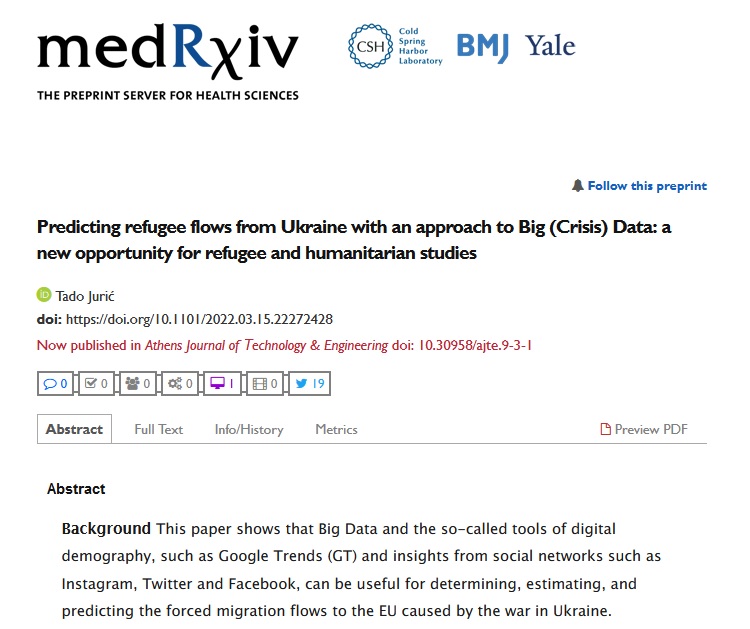Tado Juric – Migracije

Dok međunarodne organizacije naklapaju o migracijskim kretanjima iz Ukrajine (o politici i medijima da i ne govorim), moj empirijski rad već objavljen.
Dok njihov budžet za istraživanje iznosi na desetke milijardi dolara, moj je ravan =0.
Koga zanimaju rezultati – na linku:
Tado Jurić (2022). Predicting refugee flows from Ukraine with an approach to Big (Crisis) Data: a new opportunity for refugee and humanitarian studies.
Predicting refugee flows from Ukraine with an approach to Big (Crisis) Data: a new opportunity for refugee and humanitarian studies
Abstract
Background This paper shows that Big Data and the so-called tools of digital demography, such as Google Trends (GT) and insights from social networks such as Instagram, Twitter and Facebook, can be useful for determining, estimating, and predicting the forced migration flows to the EU caused by the war in Ukraine.
Objective The objective of this study was to test the usefulness of Google Trends indexes to predict further forced migration from Ukraine to the EU (mainly to Germany) and gain demographic insights from social networks into the age and gender structure of refugees.
Methods The primary methodological concept of our approach is to monitor the digital trace of Internet searches in Ukrainian, Russian and English with the Google Trends analytical tool (trends.google.com). Initially, keywords were chosen that are most predictive, specific, and common enough to predict the forced migration from Ukraine. We requested the data before and during the war outbreak and divided the keyword frequency for each migration-related query to standardise the data. We compared this search frequency index with official statistics from UNHCR to prove the significations of results and correlations and test the model’s predictive potential. Since UNHCR does not yet have complete data on the demographic structure of refugees, to fill this gap, we used three other alternative Big Data sources: Facebook, Twitter and Instagram.
Results All tested migration-related search queries about emigration planning from Ukraine show the positive linear association between Google index and data from official UNHCR statistics; R2 = 0.1211 for searches in Russian and R2 = 0.1831 for searches in Ukrainian. It is noticed that Ukrainians use the Russian language more often to search for terms than Ukrainian. Increase in migration-related search activities in Ukraine such as “граница” (Rus. border), кордону (Ukr. border); “Польща” (Poland); “Германия” (Rus. Germany), “Німеччина” (Ukr. Germany) and “Угорщина” and “Венгрия” (Hungary) correlate strongly with officially UNHCR data for externally displaced persons from Ukraine. All three languages show that the interest in Poland is the highest. When refugees arrive in nearby countries, the search for terms related to Germany, such as “crossing the border + Germany”, etc., is proliferating. This result confirms our hypothesis that one-third of all refugees will cross into Germany. According to Big Data insights, the estimate of the total number of expected refugees is to expect 5,4 Million refugees. The age group most represented is between 24 and 45 years (data for children are unavailable), and over 65% are women.
Conclusion The increase in migration-related search queries is correlated with the rise in the number of refugees from Ukraine in the EU. Thus this method allows reliable forecasts. Understanding the consequences of forced migration from Ukraine is crucial to enabling UNHCR and governments to develop optimal humanitarian strategies and prepare for refugee reception and possible integration. The benefit of this method is reliable estimates and forecasting that can allow governments and UNHCR to prepare and better respond to the recent humanitarian crisis.
Competing Interest Statement
The authors have declared no competing interest.
Funding Statement
This study did not receive any funding.
Author Declarations
I confirm all relevant ethical guidelines have been followed, and any necessary IRB and/or ethics committee approvals have been obtained.
Yes
The details of the IRB/oversight body that provided approval or exemption for the research described are given below:
Ethics committee/IRB of Catholic University of Croatia gave ethical approval for this work
I confirm that all necessary patient/participant consent has been obtained and the appropriate institutional forms have been archived, and that any patient/participant/sample identifiers included were not known to anyone (e.g., hospital staff, patients or participants themselves) outside the research group so cannot be used to identify individuals.
Yes
I understand that all clinical trials and any other prospective interventional studies must be registered with an ICMJE-approved registry, such as ClinicalTrials.gov. I confirm that any such study reported in the manuscript has been registered and the trial registration ID is provided (note: if posting a prospective study registered retrospectively, please provide a statement in the trial ID field explaining why the study was not registered in advance).
Yes
I have followed all appropriate research reporting guidelines and uploaded the relevant EQUATOR Network research reporting checklist(s) and other pertinent material as supplementary files, if applicable.
Yes
Izvor: https://www.medrxiv.org/content/10.1101/2022.03.15.22272428v1
